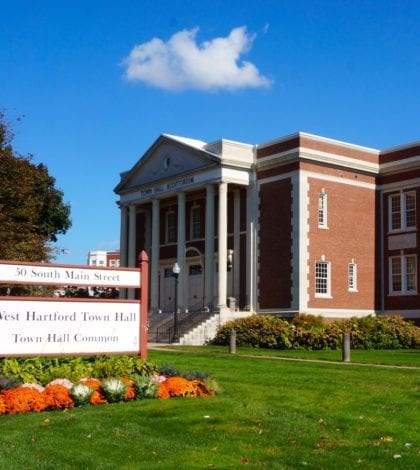West Hartford Mayor, Town Manager Respond to OPM Request

Audio By Carbonatix

West Hartford Town Hall. Photo credit: Ronni Newton
The letter of response from Mayor Shari Cantor and Town Manager Matt Hart outlines West Hartford’s track record of fiscal prudence and potential hurtful impacts of cuts to state aid.
By Abigail Albair, Editor, The West Hartford Press
Editor’s Note: This article appears courtesy of The West Hartford Press. For this and more news, see next week’s edition. To request a free, weekly copy, visit turleyct.com.
The town took a strong stance with state government this week that a “massive reduction” in state revenue will be detrimental to West Hartford.
Mayor Shari Cantor and Town Manager Matt Hart wrote a joint letter to Office of Policy and Management Secretary Benjamin Barnes, dated Aug. 16, in response to a letter he sent to all municipalities earlier this month requesting fiscal information.
The state is without a budget and in financial crisis as legislators continue to grapple with the numbers.
Barnes was asked by Gov. Dannel Malloy to provide an analysis “regarding municipal aid, local tax levels, expenditure trends, fund balances and any other criteria that could better inform our decisions.”
In his request to the town, Barnes asked for its total general fund balance for the last fiscal year and its projected balance for the current fiscal year, as well as feedback on the impact to the town caused by the “state budget impasse,” including contingency plans to utilize fund balance, issue supplemental taxes, or reduce spending, the letter states.
In their response, Hart and Cantor provide the fund balance numbers – $22,525,000 total fund balance and $21,791,000 unassigned fund balance both estimated for fiscal year 2017 and projected for fiscal year 2018 – and outline the steps West Hartford has undertaken to maintain economic strength.
In an interview with The West Hartford Press, Cantor took issue with Malloy’s initial letter to Barnes, in which he noted municipal aid as the “single largest state expenditure – more than $5 billion of our state budget,” the majority of which is educational aid, and said that, in an effort to hold municipalities harmless, the state has had to drastically alter funding to other areas of government by cutting services, raising revenues and asking state employees for concessions.
“In fact, it could be said that we have sacrificed state services and raised revenues in order to shield town government from facing difficult choices required of state leaders and implementing reforms,” Malloy wrote. “If we fail to recalibrate aid based on shifting local demographics, economies and need, we risk perpetuating an inequitable distribution of our burden among our communities. We risk not investing in the communities that should be our assets in attracting economic development, young professionals and families.”
Cantor said that, while some towns may have been protected by maintained aid and thereby avoided having to make hard choices, such has not been the case in West Hartford. Additionally, she noted the fact that Malloy’s initial budget proposal earlier this year included significant cuts to West Hartford’s state grants, but provided more funding to urban centers – a shift that she said ignored changing demographics of town and West Hartford’s status as an economic stronghold in Greater Hartford.
West Hartford, she said, is a municipality that needs continued investment as it remains one that attracts the development and population Connecticut is seeking.
She noted the number of national accolades the town has received, including, just this week, its inclusion on the Livibility.com “2017 Top 100 Best Places to Live” list. West Hartford was ranked 30th in the nation and first in the state on the list of more than 2,000 cities with populations between 20,000 and 350,000.
“The people of West Hartford cannot … face a massive reduction in state revenue or cost shift that would significantly spike property taxes and jeopardize the town’s role as Hartford’s largest neighbor and an economic anchor for the region,” Hart and Cantor wrote in their response to Barnes. “West Hartford has consistently made tough choices to consolidate administrative functions, implement cost controls, collaborate with other cities and towns, carefully invest its funds, anticipate unfunded liabilities, tax as necessary, promote innovative development, and enhance our responsiveness to an increasingly diverse community. Because we have made these tough choices, West Hartford’s economic growth and fiscal stability are major factors in the strength and future of the metropolitan region.”
The town is one of only seven municipalities in the state to have maintained a triple-A bond rating from Moody’s and Standard & Poors rating agencies, which both note in their reports that the town’s fund balance “is not fortuitous or simply a function of some untapped wealth,” but instead “it represents a track record of fiscal prudence and financial discipline.”
However, both agencies implied that, absent an increase in reserves, the town may be downgraded, the letter reads. An erosion of the town’s reserves or an increase in debt levels would yield the same result, the letter states.
Cantor and Hart said, “It is critical that the state’s action be guided by the reality rather than the perception of West Hartford.”
They note the demographics of the West Hartford public school system, which has a 41.9 percent minority population this year, including 21.4 percent of students whose home language is not English and 21.3 percent of students eligible for free and reduced lunch. Those numbers reflect an increase from a decade ago, when they were 33.4 percent, 17.6 percent and 15 percent, respectively. In that same time, AP participation saw a 74 percent increase.
Those positive results were achieved, Cantor and Hart explained, at a per pupil cost that is more than $1,000 less than the statewide average.
The town has never been given its full due in Education Cost Sharing, dipping as low as 28 percent and coming in at 58 percent of the full allotment in this fiscal year, while property taxes have increased from 69.7 percent of the town’s revenue in 2008 to 87.1 percent of the town’s revenue.
“Despite its reputation for being wealthy, West Hartford taxpayers, with varying demographic and economic backgrounds, cannot sustain such a dramatic increase in its tax burden,” Cantor and Hart wrote.
They note than fact that West Hartford is 67th in the state for median household income with 8 percent of residents living below the poverty line and grand list growth is slow, with just a .58 percent increase this fiscal year.
Despite challenges, town officials have done much work to manage liabilities, Cantor and Hart said. The pension plan is 43.3 percent funded with an unfunded liability of $234.9 million.
The town has fully funded its actuarial determined contribution, which increased from $6.1 million to $20.551 million since 2008.
Collective bargaining negotiations to change the pension plan have also yielded positive results, the letter reads.
The town has reduced its workforce by 10 percent since 1999 and lowered its net long term debt per capita by 10 percent in the last ten years, and has also realized cost savings and maximized efficiencies by regionalizing its health district and consolidating town and school district services. It has pursued savings in service contracts, made progressive changes such as bringing paramedic service in-house under the umbrella of the fire department and working with the Metropolitan District Commission and other member towns to address the challenge of the MDC’s ad valorem tax – a tax that has increased dramatically over the years to a $9.574,900 bill for 2018.
“Despite all of these efforts to manage and control costs, the town has needed to increase its mill rate to fund current services and to meet its obligations,” Cantor and Hart wrote, noting the current mill rate of 41.04.
“While we understand the difficult position the state is in, please know that any redistribution of our already underfunded Education Cost Sharing grant would negatively impact West Hartford residents, whether it be added taxes that residents cannot withstand, the elimination of important services, or additional debt obligations that would increase the financial burden for future generations; none of which would be prudent,” they wrote. “West Hartford will continue its efforts to be a well-managed, financially sound contributor to the state, region, and capital city, but we need the state’s continued support in order to do so.”
Like what you see here? Click here to subscribe to We-Ha’s newsletter so you’ll always be in the know about what’s happening in West Hartford!




West Hartford is positioned well to help the Greater Hartford area strong. Doing anything that increases the burden would be counterproductive not just for town residents and businesses but also for the entire region. West Hartford should not be penalized for having acted responsibly. If the state were to do that, there will be a decrease in responsible local governing statewide, for why would they be responsible only to find themselves kicked in the teeth for it?
[…] than 48 hours after West Hartford sent a letter to the state pleading for the preservation of the town’s Education Cos…, Gov. Dannel Malloy released a plan to shift all education aid to Alliance Districts – the […]